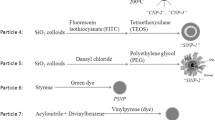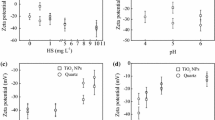Abstract
A new class of nearly charge-neutral carbon-cored nanoparticle tracers are remarkably non-interactive with solid surfaces and could provide a valuable baseline for diverse hydrological and environmental studies of subsurface flow and particle transport. We investigate the causes of inertness by studying the interactions with calcite of a nanoparticle of this class synthesized from malic acid and ethanolamine (M-dots) dispersed in brine (NaCl, CaCl2, and MgCl2) solutions. None of the M-dots are retained in calcite sand-packed columns when dispersed in DI water. Dispersed in the NaCl and mixed brine solutions, 5.6 % of and 7.3 % of the M-dots are initially retained, but 65 and 13 % of these retained particles are subsequently released when the column is flushed with DI water. When dispersed in the CaCl2 and MgCl2 solutions, 65 and 54 % of the M-dots are initially retained, and 28 and 26 % subsequently released in the DI water flush. The M-dots have a small negative zeta potential in all solutions, but the calcite zeta potential changes from strongly negative to strongly positive across the solution series, and the particle retention tracks this change. Derjaguin–Landau–Verwey–Overbeek (DLVO) modeling of the force between a calcite probe and an M-dot coated surface shows that hydration forces repel the particles in the DI water, NaCl, and mixed solutions, but not in the CaCl2 and MgCl2 solutions. These results show that near-zero charge and strongly hydrophilic decoration are the causes of the remarkable inertness of carbon-cored nanoparticles, and also suggest that nanoparticles could be useful in solute-surface interaction studies.
Graphical Abstract









Similar content being viewed by others
References
Agenet N, Perriat, P, Brichart T, Crowther N, Martini M, Tillement O (2012) Fluorescent nanobeads: a first step toward intelligent water Tracers. In: SPE international oilfield nanotechnology conference and exhibition. doi:10.2118/157019-MS
Alaskar M, Ames M, Connor S, Liu C, Cui Y, Li K, Roland H (2011) Nanoparticle and microparticle flow in porous and fractured media: an experimental study. In: SPE annual technical conference and exhibition. doi:10.2118/146752-PA
Argyris D, Tummala NR, Striolo A, Cole DR (2008) Molecular structure and dynamics in thin water films at the silica and graphite surfaces. J Phys Chem C 112(35):13587–13599
Attard P, Mitchell DJ, Ninham BW (1988) Beyond Poisson–Boltzmann: images and correlations in the electric double layer. I. Counterions only. J Chem Phys 88(8):4987–4996
Barnette AL, Asay DB, Kim SH (2008) Average molecular orientations in the adsorbed water layers on silicon oxide in ambient conditions. Phys Chem Chem Phys 10(32):4981–4986
Becker MW, Shapiro AM (2000) Tracer transport in fractured crystalline rock: evidence of nondiffusive breakthrough tailing. Water Resour Res 36(7):1677–1686
Bergström L (1997) Hamaker constants of inorganic materials. Adv Colloid Interface Sci 70:125–169
Boström M, Williams DRM, Ninham BW (2001) Specific ion effects: Why DLVO theory fails for biology and colloid systems. Phys Rev Lett 87(16):168103
Bourlinos AB, Stassinopoulos A, Anglos D, Zboril R, Georgakilas V, Giannelis EP (2008) Photoluminescent carbogenic dots. Chem Mater 20(14):4539–4541
Cail TL, Hochella MF (2005) Experimentally derived sticking efficiencies of microparticles using atomic force microscopy. Environ Sci Technol 39(4):1011–1017
Cao L et al (2007) Carbon dots for multiphoton bioimaging. J Am Chem Soc 129(37):11318–11319
Cathles LM, Spedden HR, Malouf EE (1974) A tracer technique to measure the diffusional accesability of matrix block mineralization. In: 103rd AIME annual meeting, The American Institute of Mining, Metallurgical, & Petroluem Engineers, Inc., Dallas, Texas, pp. 73–94005
Ducker WA, Senden TJ, Pashley RM (1991) Direct measurement of colloidal forces using an atomic force microscope. Nature 353(6341):239–241
Essaid HI, Bekins BA, Cozzarelli IM (2015) Organic contaminant transport and fate in the subsurface: Evolution of knowledge and understanding. Water Resour Res 51:4861–4902
Fakcharoenphol P, Kurtoglu B, Kazemi H, Charoenwongsa S, Wu Y.-S (2014) The effect of osmotic pressure on improve oil recovery from fractured shale formations. In: SPE unconventional resources conference, doi:10.2118/168998-MS
Fielden ML, Hayes RA, Ralston J (2000) Oscillatory and ion-correlation forces observed in direct force measurements between silica surfaces in concentrated CaCl2 solutions. Phys Chem Chem Phys 2(11):2623–2628
Gu J, Su S, Li Y, He Q, Shi J (2011) Hydrophilic mesoporous carbon nanoparticles as carriers for sustained release of hydrophobic anti-cancer drugs. Chem Commun 47(7):2101–2103
Horn RG, Smith DT, Haller W (1989) Surface forces and viscosity of water measured between silica sheets. Chem Phys Lett 162(4–5):404–408
Hunter RJ (1986) Foundations of colloid science. Oxford University Press, Oxford
Israelachvili J (1985) Intermolecular and surface forces. Academic Press Inc, Cambridge
Kamiya H, Mitsui M, Takano H, Miyazawa S (2000) Influence of particle diameter on surface silanol structure, hydration forces, and aggregation behavior of alkoxide-derived silica particles. J Am Ceram Soc 83(2):287–293
Kanj M (2013) Reservoir nanoagents for in-situ sensing and intervention. In: Mavroidis C, Ferreira A (eds) Nanorobotics. Springer, New York, pp 51–67
Kjellander R, Marcělja S (1984) Correlation and image charge effects in electric double layers. Chem Phys Lett 112(1):49–53
Krysmann MJ, Kelarakis A, Dallas P, Giannelis EP (2012) Formation mechanism of carbogenic nanoparticles with dual photoluminescence emission. J Am Chem Soc 134(2):747–751
Li YV, Cathles LM (2014) Retention of silica nanoparticles on calcium carbonate sands immersed in electrolyte solutions. J Colloid Interface Sci 436:1–8
Li YV, Cathles LM, Archer L (2014) Nanoparticle tracers in calcium carbonate porous media. J Nanopart Res 16(8):1–14
Lindlof JC, Stoffer KG (1983) A case study of seawater injection incompatibility. J Pet Technol 35(7):1256–1263
Marčelja S, Radić N (1976) Repulsion of interfaces due to boundary water. Chem Phys Lett 42(1):129–130
Meagher L (1992) Direct measurement of forces between silica surfaces in aqueous CaCl2 solutions using an atomic force microscope. J Colloid Interface Sci 152(1):293–295
Ohki S, Ohshima H (1999) Interaction and aggregation of lipid vesicles (DLVO theory versus modified DLVO theory). Colloids Surf B 14(1–4):27–45
Pan D, Zhang J, Li Z, Wu C, Yan X, Wu M (2010) Observation of pH-, solvent-, spin-, and excitation-dependent blue photoluminescence from carbon nanoparticles. Chem Commun 46(21):3681–3683
Pashley RM (1981) DLVO and hydration forces between mica surfaces in Li+, Na+, K+, and Cs+ electrolyte solutions: a correlation of double-layer and hydration forces with surface cation exchange properties. J Colloid Interface Sci 83(2):531–546
Pashley RM, Israelachvili JN (1984) DlVO and hydration forces between mica surfaces in Mg2+, Ca2+, Sr2+, and Ba2+ chloride solutions. J Colloid Interface Sci 97(2):446–455
Pruess K (2008) On CO2 fluid flow and heat transfer behavior in the subsurface, following leakage from a geologic storage reservoir. Environ Geol 54(8):1677–1686
Qin X, Lu W, Asiri AM, Al-Youbi AO, Sun X (2013) Microwave-assisted rapid green synthesis of photoluminescent carbon nanodots from flour and their applications for sensitive and selective detection of mercury(II) ions. Sens Actuators B 184:156–162
Ralston J, Van Vliet T, Lyklema J (1981) Inference on ion binding to polyelectrolytes from emulsion rheology. J Colloid Interface Sci 82(1):53–61
Raviv U, Klein J (2002) Fluidity of bound hydration layers. Science 297(5586):1540–1543
Ray SC, Saha A, Jana NR, Sarkar R (2009) Fluorescent carbon nanoparticles: synthesis, characterization, and bioimaging application. J Phys Chem C 113(43):18546–18551
Rodriguez, E., M. R. Roberts, H. Yu, C. Huh, S. L., and S. Bryant (2009), Enhanced Migration of Surface-Treated Nanoparticles in Sedimentary Rocks. In: SPE annual technical conference and exhibition, Society of Petroleum Engineers. doi: 10.2118/124418-MS
Sang W, Morales VL, Zhang W, Stoof CR, Gao B, Schatz AL, Zhang Y, Steenhuis TS (2013) Quantification of colloid retention and release by straining and energy minima in variably saturated porous media. Environ Sci Technol 47(15):8256–8264
Saraji S, Goual L, Piri M (2013) Dynamic adsorption of asphaltenes on quartz and calcite packs in the presence of brine films. Colloids Surf A 434:260–267
Subramanian SK, Li Y, Cathles LM (2013) Assessing preferential flow by simultaneously injecting nanoparticle and chemical tracers. Water Resour Res 49(1):29–42
Valle-Delgado JJ, Molina-Bolivar JA, Galisteo-Gonzalez F, Galvez-Ruiz MJ, Feiler A, Rutland MW (2005) Hydration forces between silica surfaces: experimental data and predictions from different theories. J Chem Phys 123(3):034708
Wang X, Qu K, Xu B, Ren J, Qu X (2011) Microwave assisted one-step green synthesis of cell-permeable multicolor photoluminescent carbon dots without surface passivation reagents. J Mater Chem 21(8):2445–2450
Yan A, Lau BW, Weissman BS, Külaots I, Yang NYC, Kane AB, Hurt RH (2006) Biocompatible, hydrophilic, supramolecular carbon nanoparticles for cell delivery. Adv Mater 18(18):2373–2378
Yu H, Kotsmar C, Yoon KY, Ingram DR, Johnston KP, Bryant SL, Huh C (2010) Transport and retention of aqueous dispersions of paramagnetic nanoparticles in reservoir rocks. In: SPE improved oil recovery symposium, society of petroleum engineers. doi: 10.2118/129887-MS
Acknowledgments
This publication is based on work supported by Award No. KUS-C1-018-02 from the King Abdullah University of Science and Technology and by ARI project from Department of Energy. Support was also provided by a general fund contribution to L. Cathles from The International Research Institute of Stavanger.
Author information
Authors and Affiliations
Corresponding author
Rights and permissions
About this article
Cite this article
Li, Y.V., Cathles, L.M. The surface interactions of a near-neutral carbon nanoparticle tracer with calcite. J Nanopart Res 18, 71 (2016). https://doi.org/10.1007/s11051-016-3383-4
Received:
Accepted:
Published:
DOI: https://doi.org/10.1007/s11051-016-3383-4




